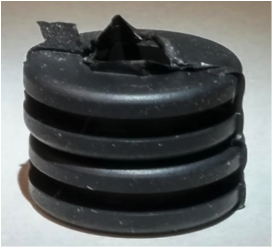Rubber injection molds are designed for an efficient, cost effective molding process, including lowest possible cycle time, maximized cavity count, and minimal material waste. A small amount of material waste can be in the form of edge waste, or flash as we call it in the industry. This is the unwanted, fine, feathery rubber extension caused by raw material leaking into the mold parting line during the molding and curing process. Flashless molding is the most ideal choice to eliminate flash altogether. When flashless molding cannot be achieved, there are a variety of secondary operations available to address the flash.
Prevention
Our first, and most ideal, choice is flashless molding. It is the ultimate mold, box, and ship process. This type of molding can reduce not only material costs, but also labor costs associated with flash removal, plus any potential for scrap that might be associated with an accidental rip or tear during the finishing operations. To successfully execute flashless molding, parts are configured properly, molds are carefully designed, specially compounded rubber formulas are used, properly sized presses are selected, and a precise molding process is developed and followed. When these items are in balance, flashless molding is effective.
Removal
The lowest cost removal process is to manually tear trim the flash from the part directly after demolding. In this case, the mold designer plans for a very narrow and thin area of rubber directly around the part at the parting line and just beyond that a thicker, ring-like feature. Generally after demolding, the press operator can tug on the ring feature to pull off the flash, leaving behind generally no more than 0.016″ extension, and often times less. Tear trim not only avoids an added cryogenic deflashing operation, but also eliminates additional movement in the manufacturing facility.
Rubber parts requiring even more precise flash removal are cryogenically deflashed. In a batch process, the parts are first chilled until they reach the polymer’s glass transition temperature. This is the point where the polymer, or rubber, transitions from its normal rubbery softness to a brittle material. The parts are then tumbled and blasted with small nylon beads. Because the thin flash reaches the glass transition temperature before the thicker part cross-sections, the thin flash is very effectively and efficiently removed without damaging the part.
If a part requires a tight tolerance or a surface finish that cannot be produced by the mold, it may be ground or machined. During this operation, the flash is also addressed. Grinding or machining is the most labor intensive operation of the three discussed.
If you’re a designer, and have the option to design for a flashless molded part, choose this. If not, but are able to allow for tear trim extension, we recommend it. If you’re a buyer and looking for cost reductions, we hope we have given you some knowledge about different finishing operations.




